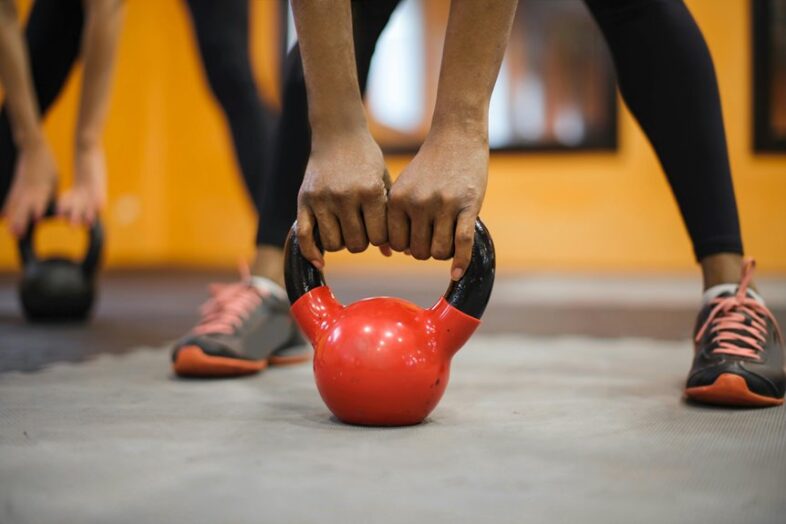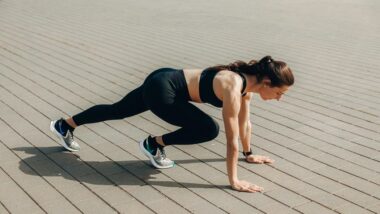Kettlebell leg exercises improve lower-body strength and overall fitness by targeting key muscle groups. Exercises like sumo squats and goblet squats build leg strength, while kettlebell swings enhance athleticism. These exercises engage the core, improve balance, and strengthen the lower back. A well-structured kettlebell leg workout routine can be tailored to individual needs, improving overall fitness and reducing injury risk. By exploring various kettlebell exercises and techniques, individuals can discover a more thorough approach to building strong, resilient legs. Further exploration of kettlebell leg exercises can reveal a wide range of benefits and training possibilities.
Key Takeaways
- Kettlebell leg exercises improve strength and fitness.
- Goblet squats and sumo squats target key muscle groups.
- Kettlebell swings enhance overall fitness and athleticism.
- Leg strength increases up to 20% with kettlebell exercises.
- Kettlebell workouts improve balance, stability, and core strength.
Kettlebell Leg Exercises Overview
Numerous kettlebell leg exercises are available to individuals seeking to improve their lower-body strength and overall fitness. These exercises offer a thorough leg workout, targeting various muscle groups to enhance overall strength and stability. The kettlebell leg exercises, including Sumo Squats and goblet squat, are effective for building Lower Body Strength.
A kettlebell leg workout can be tailored to suit individual needs, incorporating exercises such as Sumo Squats, which target glutes and quads.
The goblet squat is another essential exercise, requiring a kettlebell to be held at chest height, promoting balance and Lower Body Strength.
By incorporating these exercises into a leg workout routine, individuals can experience significant improvements in their overall fitness and sense of belonging to a community that values strength and wellness.
Kettlebell leg exercises provide a versatile and challenging way to improve Lower Body Strength, making them an excellent addition to any fitness routine, and a great way to enhance a kettlebell leg workout.
Engaging in kettlebell leg exercises also requires an understanding of proper form and technique to maximize effectiveness and prevent injuries.
Lower Body Strength Training
Lower body strength training is essential for overall physical fitness, and kettlebell exercises are an effective way to achieve this goal by targeting key muscle groups such as the quadriceps, hamstrings, and glutes.
Developing leg strength through kettlebell exercises like squats, deadlifts, and lunges can enhance athletic performance, improve balance and stability, and reduce the risk of injury.
Incorporating kettlebell exercises into a workout routine can also improve posterior chain strength, which is critical for overall functional fitness and athletic performance.
Leg Strength
Three key muscle groups – quadriceps, hamstrings, and glutes – are effectively targeted by kettlebell exercises such as goblet squats, sumo squats, and lunges, making them a valuable addition to any leg strength training program. These exercises engage the core, improve balance, and strengthen the lower back, resulting in overall leg strength. The glutes, in particular, benefit from kettlebell exercises, as they are responsible for hip extension and external rotation.
Incorporating kettlebell exercises into a lower body strength training program can lead to significant gains in leg strength. Research has shown that kettlebell training can increase leg strength by up to 20% in just 6 weeks. Exercises like kettlebell step-ups and single-leg deadlifts require engagement of the core and stabilization of the body, making them effective for improving balance and leg strength.
Body Training
Building on the foundation of leg strength, a well-rounded body training program must incorporate exercises that target the entire lower body. This includes the leg, core, and back muscles, which work together to maintain balance and stability.
Exercises like the goblet squat and sumo squat target the quadriceps, hamstrings, and glutes, while also engaging the core muscles. Kettlebell step-ups and single-leg deadlifts also work the leg muscles, requiring core engagement and balance.
To keep the body strong and resilient, it is crucial that rest and recover adequately between workouts. This allows the muscles to repair and rebuild, making them stronger over time. By incorporating a variety of kettlebell exercises into a body training program, individuals can keep their lower body strong and stable, reducing the risk of injury and improving overall athletic performance. Regular exercise and rest can help maintain a healthy body and back, leading to overall well-being.
Kettlebell Squat Techniques
Several kettlebell squat techniques are essential for a well-rounded workout routine, each offering unique benefits and challenges. The kettlebell squat is a fundamental exercise that targets the core muscles and legs. To perform a proper kettlebell squat, it is vital to maintain a neutral spine and engage the core muscles.
One technique involves holding a single kettlebell at chest height and lowering into a squat, while another requires holding the kettlebell in the racked position and resting it on the back of each shoulder. A wide stance, such as in a sumo squat, can also be used to target different muscle groups. To add variety, alternate sides by holding the kettlebell on one side and then switching to the other.
Kettlebell workouts, including squats, can help improve overall core strength and enhance balance and coordination, making them an effective tool for total-body conditioning.
Leg Workout Routine Ideas
Crafting a thorough leg workout routine with kettlebells involves combining exercises that target various muscle groups, including the quadriceps, hamstrings, glutes, and core. This approach helps build overall lower-body strength and mobility. A leg workout routine can be completed in 15 minutes using a single kettlebell, with 45 seconds of work followed by 25 seconds of rest, and repeating six exercises with a bonus exercise at the end.
Incorporating exercises like goblet squats, sumo squats, swings, and tactical lunges provides an all-encompassing challenge to the legs, glutes, and core. Alternating between exercises like kettlebell step-ups, Bulgarian split squats, and one-legged deadlifts adds variety to the routine and helps improve strength.
To create an effective leg workout routine, focus on proper form and technique, start with a comfortable kettlebell weight, and gradually increase the weight or difficulty as strength and endurance improve. This structured approach to kettlebell leg exercises helps individuals achieve their fitness goals and build a strong, supportive community that values strength and wellness.
A well-designed kettlebell leg workout routine can be a valuable asset in any fitness journey. Wearing kettlebell guards during these exercises can help prevent injuries and provide comfort, allowing for a more intense and focused workout.
Kettlebell Deadlift Variations
Kettlebell deadlift variations offer a range of options for targeting different muscle groups and accommodating individual preferences or needs. The kettlebell deadlift is a compound exercise that works multiple muscle groups, including the posterior chain, making it effective for building strength and muscle mass.
Sumo deadlifts, in particular, place less stress on the lower back, making them suitable for beginners. They work glutes, adductors, hamstrings, quadriceps, back, core, and calves. Using kettlebells, individuals can perform sumo deadlifts with feet positioned wider than shoulder-width apart, engaging the core and maintaining a neutral spine.
Single-leg deadlifts are another variation, involving a standing position with a kettlebell in one or both hands, sliding the other leg back while lowering the kettlebell toward the floor. This exercise targets glutes, hamstrings, lower back, and core. The kettlebell sumo deadlift is a specific variation that requires a wide stance and engagement of the core. By incorporating these exercises into a routine, individuals can experience the benefits of kettlebell deadlift variations, including improved strength and muscle mass. Using kettlebells in a standing position allows for a range of motions and exercises, making them a versatile tool for leg exercises. Incorporating kettlebell swings into a workout routine can also enhance overall fitness and athleticism, as it works multiple muscle groups and improves cardiovascular health.
Effective Leg Building Exercises
Numerous exercises can be employed to effectively build leg strength, with kettlebell swings being a highly effective option, as they target the posterior chain, including glutes and hamstrings, by utilizing a wide stance and slight knee bend to generate power and momentum. This exercise requires engaging the hips forward to maximize the swing's effectiveness. In addition to swings, other kettlebell exercises like goblet squats and sumo squats can be used to build leg strength, targeting multiple muscle groups including the glutes, quadriceps, and hamstrings.
To further challenge the legs, one leg exercises like kettlebell step-ups and single-leg deadlifts can be utilized. These exercises target the quadriceps, glutes, and hamstrings, while also challenging balance and stability. By standing on one leg and performing a stiff-legged deadlift with a kettlebell, individuals can build strength and stability in the legs, particularly in the glutes and hamstrings. These exercises can help individuals achieve stronger, more resilient legs, and improve overall lower body strength.
Kettlebell Workout Benefits
Building on the foundation of effective leg exercises, it's clear that incorporating kettlebells into a workout routine can have a significant impact on overall lower body strength and fitness. The kettlebell workout benefits are numerous, including improved strength, flexibility, and mobility in the legs, glutes, and hips. By incorporating kettlebell leg exercises, such as squats and lunges, individuals can burn calories, strengthen their leg back, and improve overall fitness.
To stay balanced and keep the weight, kettlebell exercises engage the entire body, including the core muscles. This leads to improved balance, stability, and overall functional fitness. Regularly performing kettlebell leg exercises can also lead to improved bone density and enhanced cardiovascular fitness.
As a result, kettlebell workout benefits extend beyond the legs, promoting overall wellness and fitness. By adding kettlebell exercises to a fitness routine, individuals can experience these benefits and improve their overall health, making them a valuable addition to a well-rounded fitness program that targets the entire body.
Frequently Asked Questions
Are Kettlebells Good for Leg Workouts?
Incorporating kettlebells enhances leg strength, promotes muscle growth, supports weight loss, and advances fitness goals, ultimately elevating athletic performance within a balanced exercise routine.
How Do You Tone Your Legs With a Kettlebell?
Toning legs coincides with leg day, incorporating exercise variety into your fitness routine to boost leg strength, promoting muscle growth and community belonging among like-minded individuals.
Is 20 Minutes of Kettlebells Enough?
Twenty minutes of kettlebells can be sufficient, depending on workout length, exercise frequency, and fitness goals, incorporating kettlebell training sessions into daily routines, to achieve desired outcomes, considering individual Kettlebell duration.
Will Kettlebell Swings Tone Legs?
Research confirms kettlebell swings promote muscle growth, contributing to leg development, and can be a valuable addition to workout plans, supporting overall fitness goals and amplifying kettlebell benefits.
Conclusion
Kettlebell leg exercises offer thorough lower body strength training. As the adage "practice makes perfect" suggests, consistent practice yields ideal results. Effective leg building exercises, including kettlebell squats and deadlifts, contribute to overall physical fitness. Regular kettlebell workouts enhance strength and endurance, making them a valuable addition to any fitness regimen.


